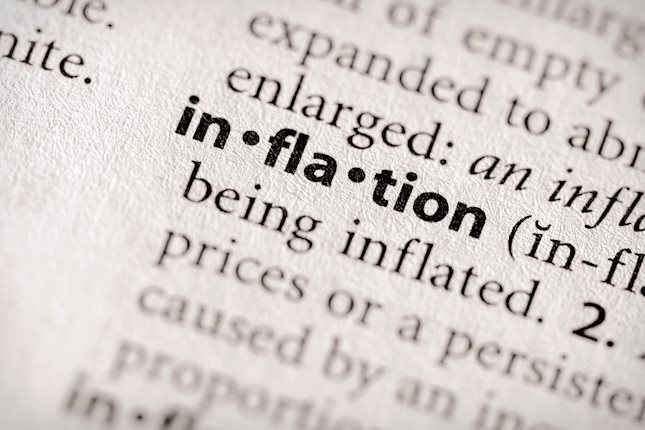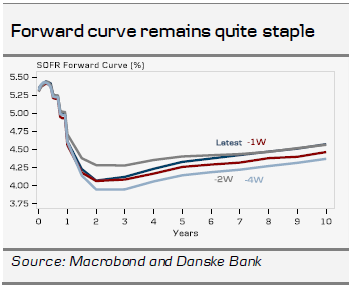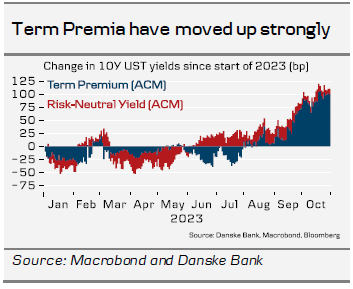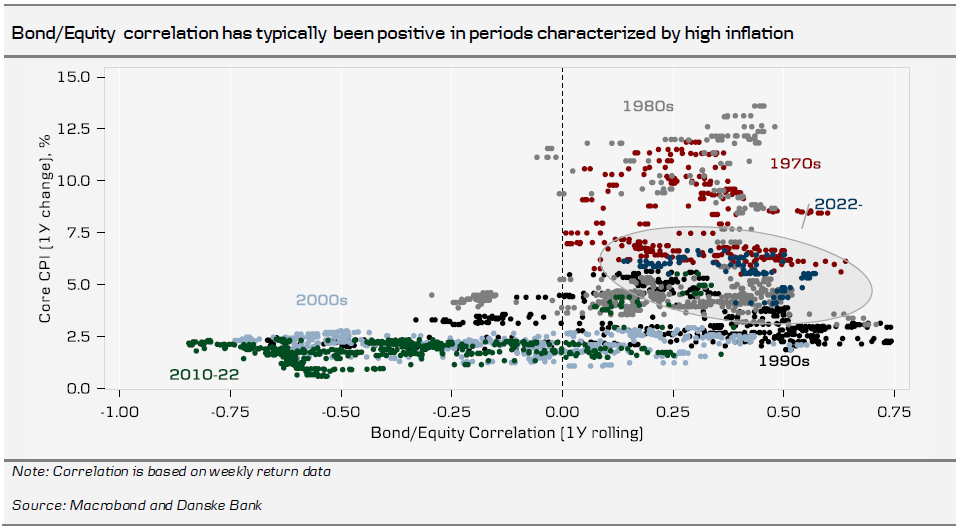-
Bond market outlook remains blurred by high issuance, debt sustainability worries as well as uncertainty over economic outlook and inflation. We continue to forecast lower long-end yields, but less than previously.
-
We see 10y UST yield at 4.20% in 12M horizon (from 3.70%). We also revised up our US GDP forecast to 2.4% for 2023 (from 2.1%) and 1.1% for 2024 (from 0.9%), reflecting stronger realized data but still weak outlook.
10Y UST yields have generally traded in the 4.80-5.00% range over the past weeks but broke below the recent range following the November FOMC Meeting. Yields remain caught in crosswinds stemming from data, market dynamics and monetary policy.
On the latter, Powell struck a rather balanced tone at the press conference following yesterday’s FOM C meeting, emphasising that the committee sees progress on inflation/labour market data but is not yet convinced that financial conditions are sufficiently restrictive. Wage growth remains elevated, excess labour demand is still present and growth continues to surprise to the upside. The ‘high for longer’ narrative has clearly been adopted by markets, which is visible in the noticeable staple pricing of the SOFR forward curve to bottom at a level above 4% in 2025 (see right-hand chart).
Dire deficit outlook justifies a higher-term Premium
Apart from data and monetary policy, bond markets remain highly impacted by supply/demand dynamics encapsulated in the move up in the Term Premium since the summer (see right-hand chart). The US debt outlook is in centre of these discussions, after the Treasury’s sizeable upward revision of expected issuance in August. However, recent announcements on issuance have brought some calm to markets.
Earlier this week, the Treasury lowered its expected issuance for the remainder of the year, while signalling that the cash buffer (TGA) is now sufficiently refilled after being drained in the lead-up to the debt ceiling resolution in June. According to the Quarterly Refunding Statement out Wednesday, issuance for the remainder of the year will mainly pick up at the belly of curve, while selling in the long end will decline marginally in December and January. A continued high share of T-Bills in the issuance profile indicates, that the short end will continue to bear a significant share of US deficit burden. Markets had clearly feared a more significant amount of duration to accommodate in the short run.
On the demand side, investors still seems cautious to take on more duration risk in the current situation. Powell mentioned in his speech at The Economic Club of New York earlier this month that the FOMC is looking at the current positive bond/equity correlation as a potential driver of Term Premia. Bonds have become less useful for hedging risk. Bonds and equities share a common exposure to inflation, and historically the two have correlated positively in decades characterized by elevated price pressures as the 1970s and 1980s (see chart below on page 2). As economic growth slows and inflationary risks dampen, the positive correlation will likely recede gradually from here.
This publication has been prepared by Danske Bank for information purposes only. It is not an offer or solicitation of any offer to purchase or sell any financial instrument. Whilst reasonable care has been taken to ensure that its contents are not untrue or misleading, no representation is made as to its accuracy or completeness and no liability is accepted for any loss arising from reliance on it. Danske Bank, its affiliates or staff, may perform services for, solicit business from, hold long or short positions in, or otherwise be interested in the investments (including derivatives), of any issuer mentioned herein. Danske Bank's research analysts are not permitted to invest in securities under coverage in their research sector.
This publication is not intended for private customers in the UK or any person in the US. Danske Bank A/S is regulated by the FSA for the conduct of designated investment business in the UK and is a member of the London Stock Exchange.
Copyright () Danske Bank A/S. All rights reserved. This publication is protected by copyright and may not be reproduced in whole or in part without permission.
Recommended Content
Editors’ Picks

EUR/USD regains 1.0500 and beyond as US Dollar wilts ahead of data
EUR/USD is extending the rebound above 1.0500 in the European session on Wednesday. Traders cash in on the US Dollar long positions ahead of a series if top-tier US data, lifting the pair. The USD/JPY sell-off also adds to the US Dollar downside.

GBP/USD holds gains near 1.2600, US PCE data eyed
GBP/USD extends the bullish momentum to trade near 1.2600 in European trading on Wednesday. The pair remains underpinned by a sustained US Dollar weakness and risk-off sentiment as traders turn cautious ahead of top-tier US data releases.

Gold price climbs above $2,650 on trade war concerns, sliding US bond yields and softer USD
Gold price sticks to modest intraday gains near a two-day high, above the $2,650 level, through the first half of the European session as geopolitical risks and US President-elect Donald Trump's tariff plans drive haven flows for the second straight day.

US core PCE inflation set to hold steady, raising doubts on further Federal Reserve rate cut
The United States Bureau of Economic Analysis (BEA) is set to release the Personal Consumption Expenditures (PCE) Price Index data for October on Wednesday at 13:30 GMT.

Eurozone PMI sounds the alarm about growth once more
The composite PMI dropped from 50 to 48.1, once more stressing growth concerns for the eurozone. Hard data has actually come in better than expected recently – so ahead of the December meeting, the ECB has to figure out whether this is the PMI crying wolf or whether it should take this signal seriously. We think it’s the latter.

Best Forex Brokers with Low Spreads
VERIFIED Low spreads are crucial for reducing trading costs. Explore top Forex brokers offering competitive spreads and high leverage. Compare options for EUR/USD, GBP/USD, USD/JPY, and Gold.


